Choosing a new bicycle can feel overwhelming. With countless options available, from local bike shops to online retailers, and a vast array of bike types, knowing where to even begin your search can be daunting. But don’t worry, usabikers.net is here to simplify the process and guide you to the perfect bike.
This comprehensive guide will walk you through every step of buying a bike, from understanding your cycling goals and setting a realistic budget, to finding the right place to buy and ensuring the perfect fit. We’ll cover everything you need to know to make an informed decision and confidently choose the bike of your dreams.
Let’s get started with the ultimate guide to buying a bike, broken down into clear, manageable steps:
1. Define Your Cycling Goals
Before you even think about where to buy a bike, the most crucial first step is to determine what you want to achieve with your new bicycle. Understanding your cycling goals will immediately narrow down the type of bike that’s right for you.
When considering the best bike for your needs, you’ll generally encounter these primary categories: road bikes, mountain bikes, hybrid bikes, gravel bikes, folding bikes, city bikes, and singlespeed/fixie bikes. Each type is designed for different riding styles and terrains.
Bike design is heavily influenced by function. While many bikes offer some versatility for commuting, errands, and recreational rides, pinpointing your primary goals will lead you to a bike that’s much better suited to your specific intentions.
A very common goal for many is to incorporate cycling into their daily commute, ditching crowded public transport or the expenses and environmental impact of driving.
For those in regions with initiatives like the UK’s Cycle to Work schemes, purchasing a bike can be a financially advantageous and tax-efficient option. If you’re outside the UK, investigate whether your local government provides similar programs to encourage cycling.
Commuting by Bike?
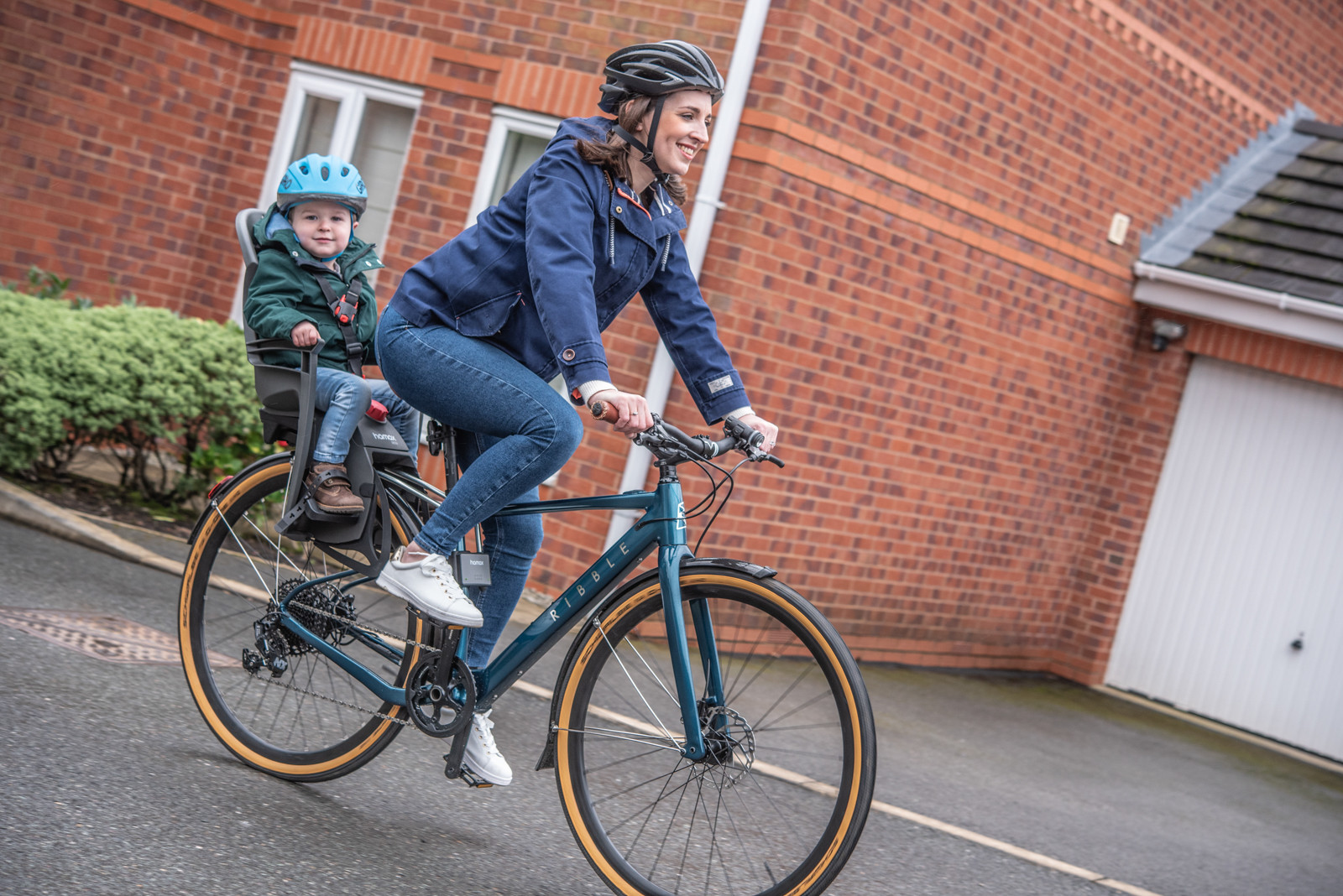 Electric hybrid bike with a child seat, showcasing a practical commuting solution
Electric hybrid bike with a child seat, showcasing a practical commuting solution
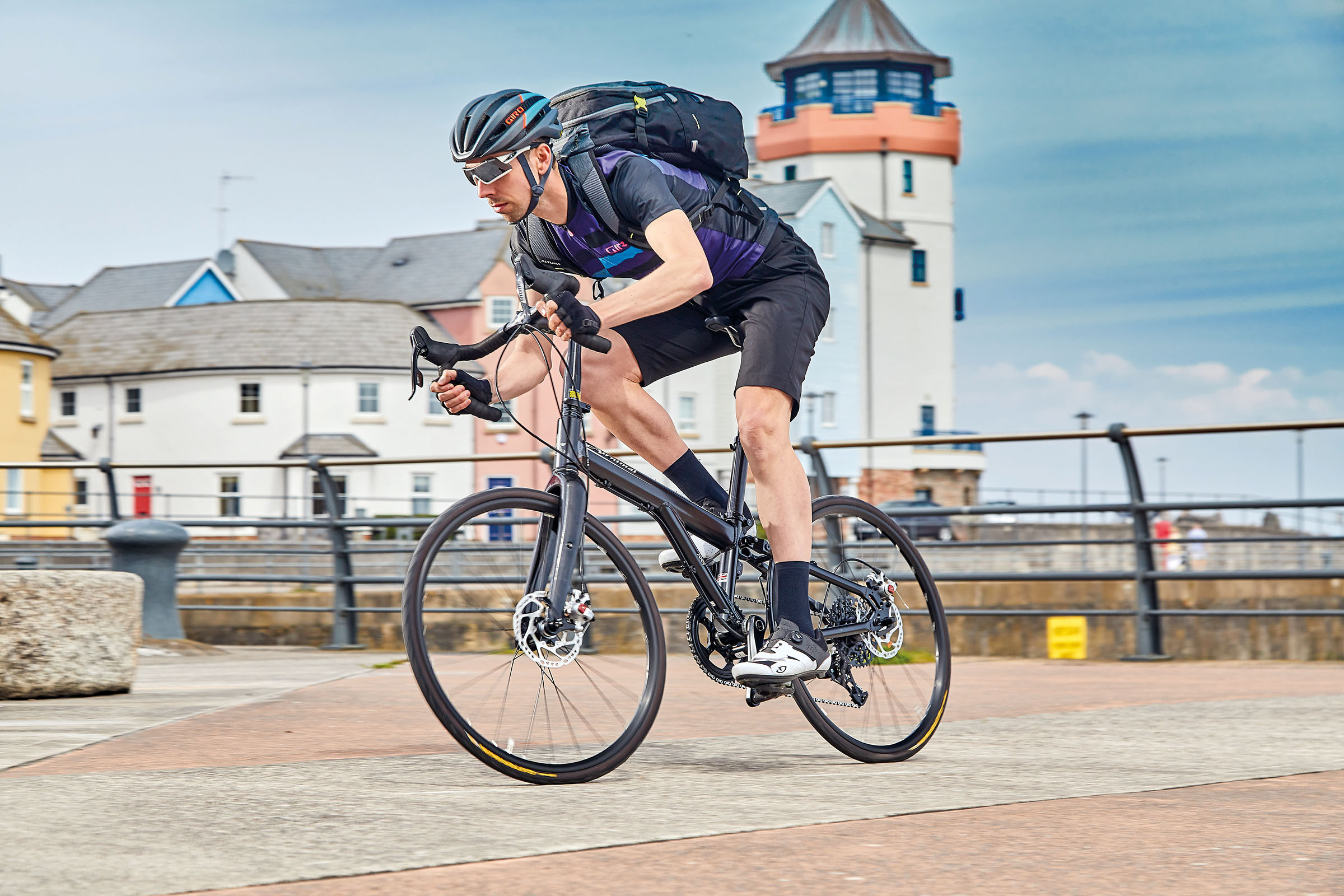 Cyclist on a blue bike by the harbor, illustrating the joy and fitness benefits of bike commuting
Cyclist on a blue bike by the harbor, illustrating the joy and fitness benefits of bike commuting
What is the ideal bike for commuting? Many commuters find flat handlebar bikes, such as hybrid bikes, to be the best choice. Hybrid bikes are designed to balance speed, comfort, and versatility, offering a more upright riding posture that many prefer for navigating city streets.
Drop-bar road bikes are also viable for commuting, particularly models specifically engineered for the daily ride. These road bikes often include features like mudguard and rack mounts, making them practical for all-weather commuting and carrying essentials. Road bikes are generally faster than hybrids, which can be beneficial for longer commutes.
For any regular bike commute, installing mudguards is highly recommended to protect yourself from rain and road spray. Adding a rear rack can also significantly improve comfort by allowing you to carry luggage without the strain of a backpack.
Beyond commuting, both hybrid and road bikes are excellent for weekend explorations on country roads and bike paths, offering versatility for both practical and recreational riding.
Road Cycling Enthusiast?
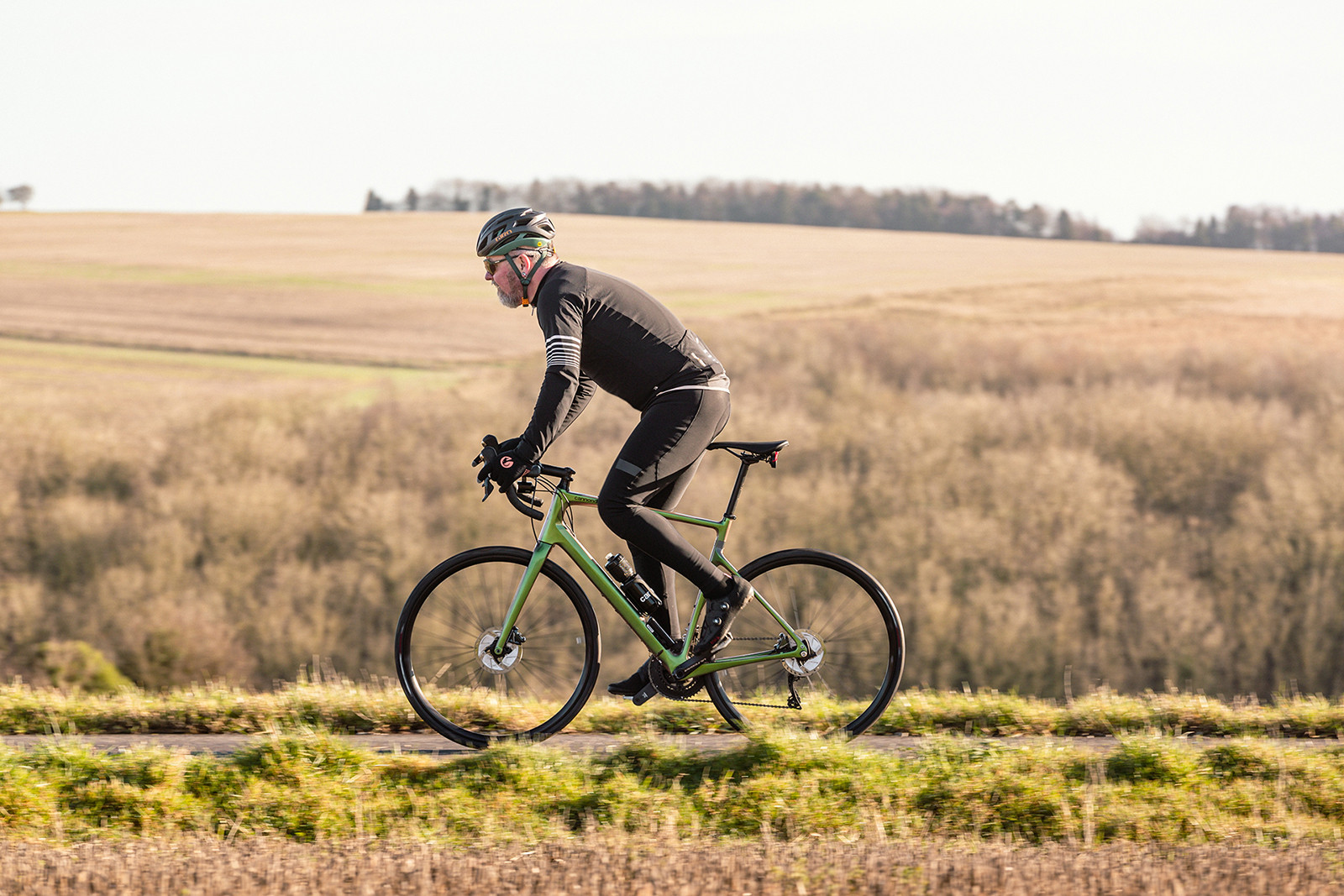 Cannondale Synapse Carbon 2 RL road bike on a scenic road, highlighting the speed and performance of road bikes
Cannondale Synapse Carbon 2 RL road bike on a scenic road, highlighting the speed and performance of road bikes
If your cycling ambitions are more performance-oriented or involve longer distances primarily on paved roads, then drop-bar bikes are almost certainly the way to go.
Within road bikes, you’ll find two main categories: race-focused bikes with an aggressive, aerodynamic riding position, and endurance bikes designed for greater comfort over longer rides with a more upright posture.
Unless you’re actively involved in racing, an endurance road bike is generally the more sensible choice. These bikes feature a more relaxed geometry and often offer increased versatility with greater tire clearance and mounting points for accessories like mudguards and racks.
For riders prioritizing speed and performance and confident in a more aerodynamic posture, aero road bikes are engineered for maximum velocity, while climbing bikes are optimized for lightweight efficiency on uphill routes.
Adventure on Trails?
If your cycling passion leads you to trails, then a mountain bike is essential. Whether you’re an outdoor enthusiast seeking deeper exploration of nature or eager to tackle local trail centers and bike parks, a mountain bike is your tool.
Mountain biking demands an upright riding position for enhanced control, wide, grippy tires, a broad gear range for varying terrain, and powerful brakes for confident descents.
Bridging the gap between road and mountain bikes, gravel bikes have become a popular option. They feature drop handlebars but incorporate robust gravel bike tires with significant grip. This combination allows you to confidently navigate towpaths, gravel tracks, and bridleways, while still maintaining reasonable speed on paved roads.
Considering an Electric Bike?
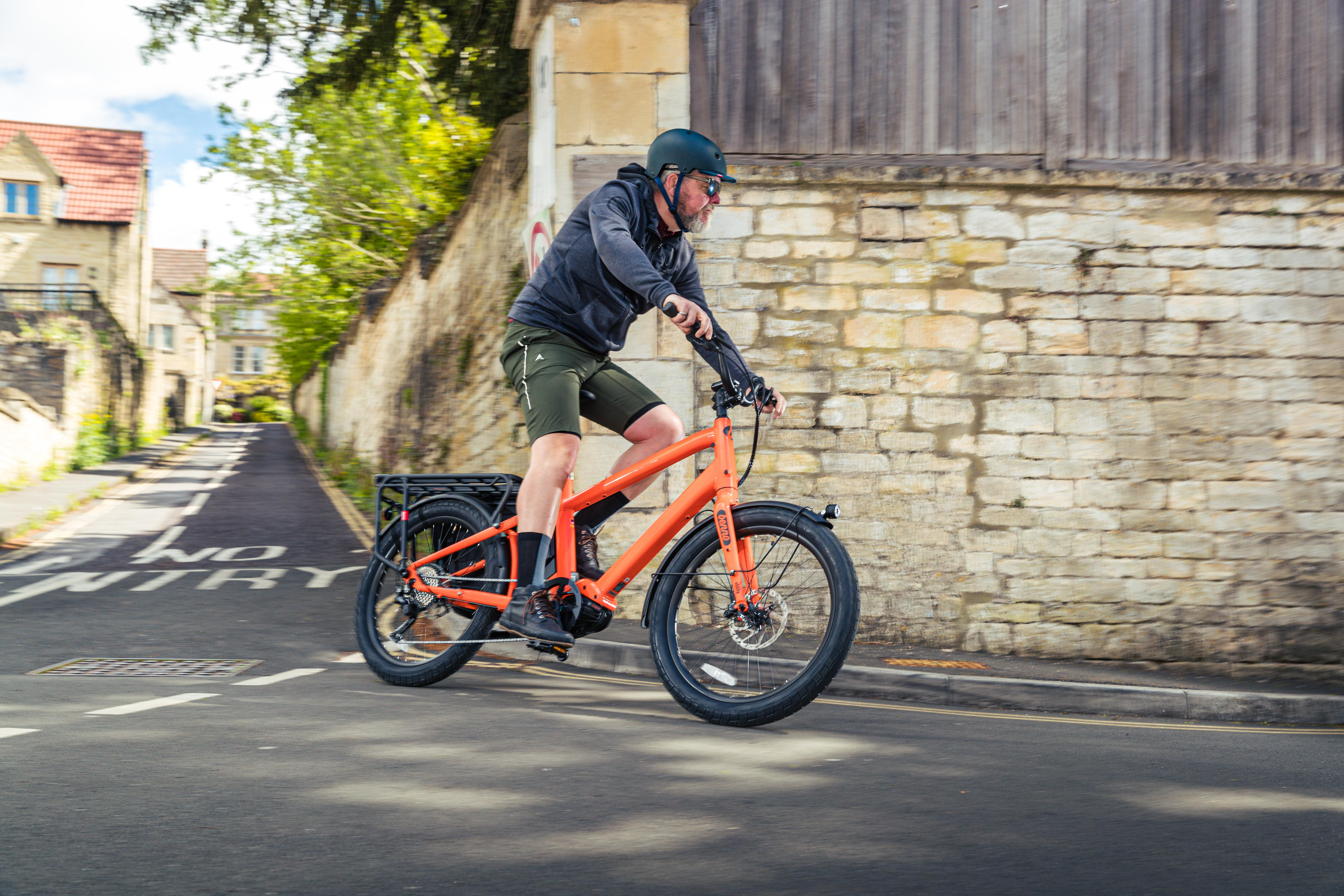 Electric bike parked in a city setting, representing the accessibility and convenience of e-bikes
Electric bike parked in a city setting, representing the accessibility and convenience of e-bikes
If you’re concerned about fitness levels or desire assistance on hilly routes, an electric bike is worth considering. Recent advancements in battery and motor technology have made electric bikes a genuinely advantageous option, particularly for conquering hills and accelerating from stops.
Electric versions are now available across nearly all bike categories, from flat-bar hybrid electric bikes to electric mountain bikes. You can even find sleek electric road bikes with drop bars and integrated motors that maintain a sporty aesthetic.
Urban Cycling Needs?
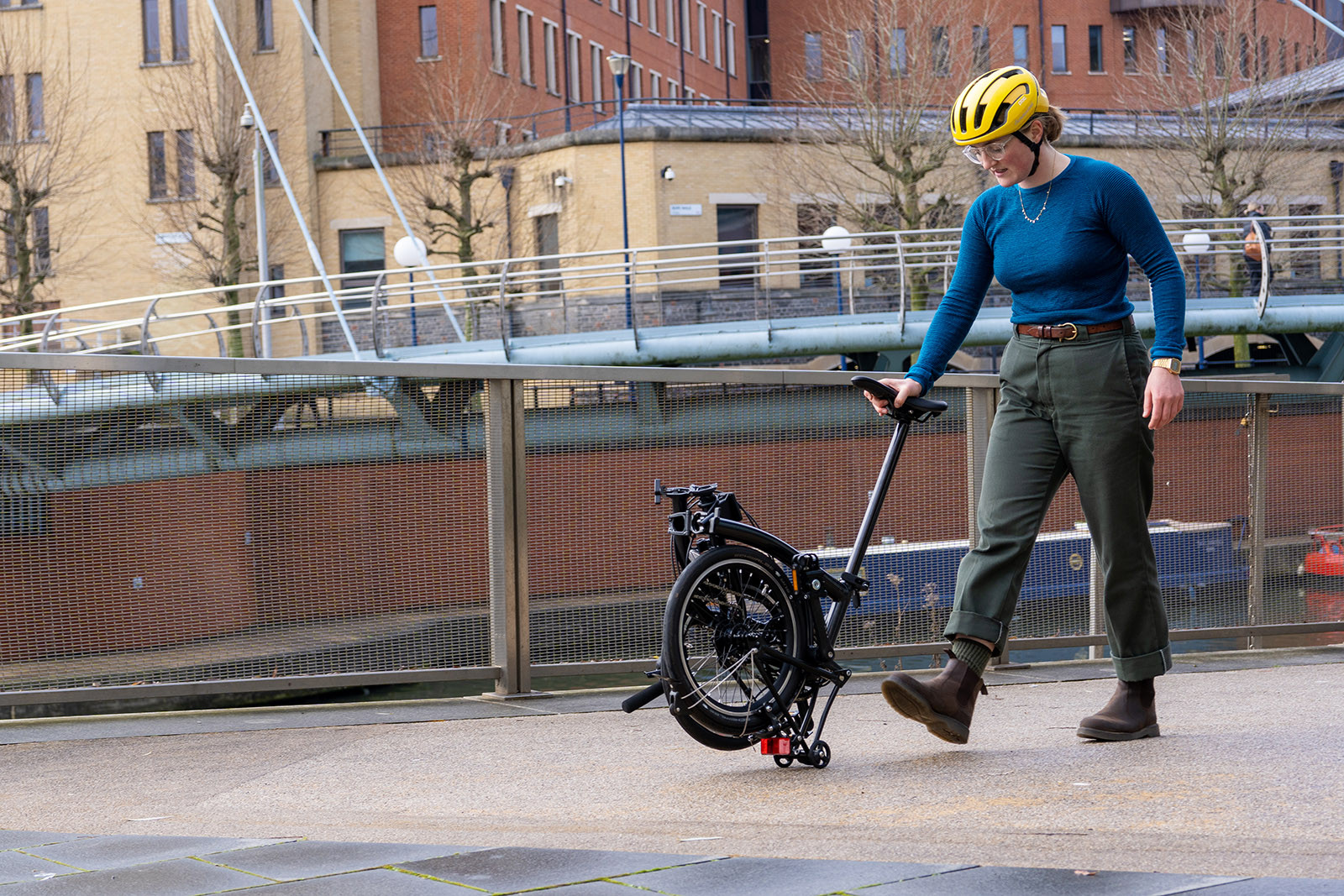 Brompton folding bike folded, demonstrating the space-saving and portability of folding bikes
Brompton folding bike folded, demonstrating the space-saving and portability of folding bikes
For those planning ‘mixed-mode’ commutes, such as incorporating train travel, a folding bike could be the perfect solution.
While generally a bit slower and heavier than standard bikes, folding bikes offer unmatched convenience for storage and portability. They allow you to easily navigate rush-hour trains or store the bike under a desk, situations where a full-size bike would be impractical. The high-end market also includes electric folding bikes, combining portability with electric assistance.
If your journeys are short and your terrain is flat, a city bike, often called a ‘Dutch bike,’ is a practical choice. Known for their upright riding position and dignified style, they are ideal for simple, relaxed transportation.
Similarly, singlespeed or fixie bikes are well-suited for urban riding due to their simplicity and low maintenance. Originally designed for indoor track racing, fixies have a direct drive – you must pedal to move. However, many models offer the option to switch to a singlespeed setup with a freewheel for coasting.
2. Establish Your Budget
 Triban RC500 road bike, representing a quality bike at an accessible price point
Triban RC500 road bike, representing a quality bike at an accessible price point
Once you’ve determined the type of bike you need, the next critical step is to define your budget. How much are you prepared to invest in your new bike?
Non-motorized bikes typically start around £200 and go upwards. Bikes priced lower than this are often of questionable quality and may not offer a reliable or enjoyable riding experience.
For those looking for a quality cheap road bike, cheap mountain bike, cheap gravel bike, or a good hybrid, a budget between £500 and £750 is a solid starting point. At this price range, you begin to see bikes with well-designed, relatively lightweight frames and dependable branded components. Crucially, bikes in this range are more likely to be durable. One common weakness of very cheap bikes is that even if they function adequately when new, their longevity can be compromised.
If your budget allows, and you plan to use your bike frequently, increasing your spending to around £1,000 is highly recommended. At this level, the best road bikes under £1,000 and best mountain bikes under £1,000 start to feature higher-quality components and frames that are worth upgrading as your cycling skills and enthusiasm grow.
Of course, the potential spending on a bicycle is virtually limitless. Top-tier road, mountain, and gravel bikes can easily reach five-figure price tags. As with any premium purchase, the law of diminishing returns applies, but for dedicated cyclists, investing between £2,000 and £4,000 will generally secure a truly top-quality bike.
3. Decide Where to Buy Your Bike
Now that you know what type of bike you want and how much you’re willing to spend, the next key decision is where to buy a bike. You have several options, each with its own advantages: local bike shops, online retailers, and direct-sales brands.
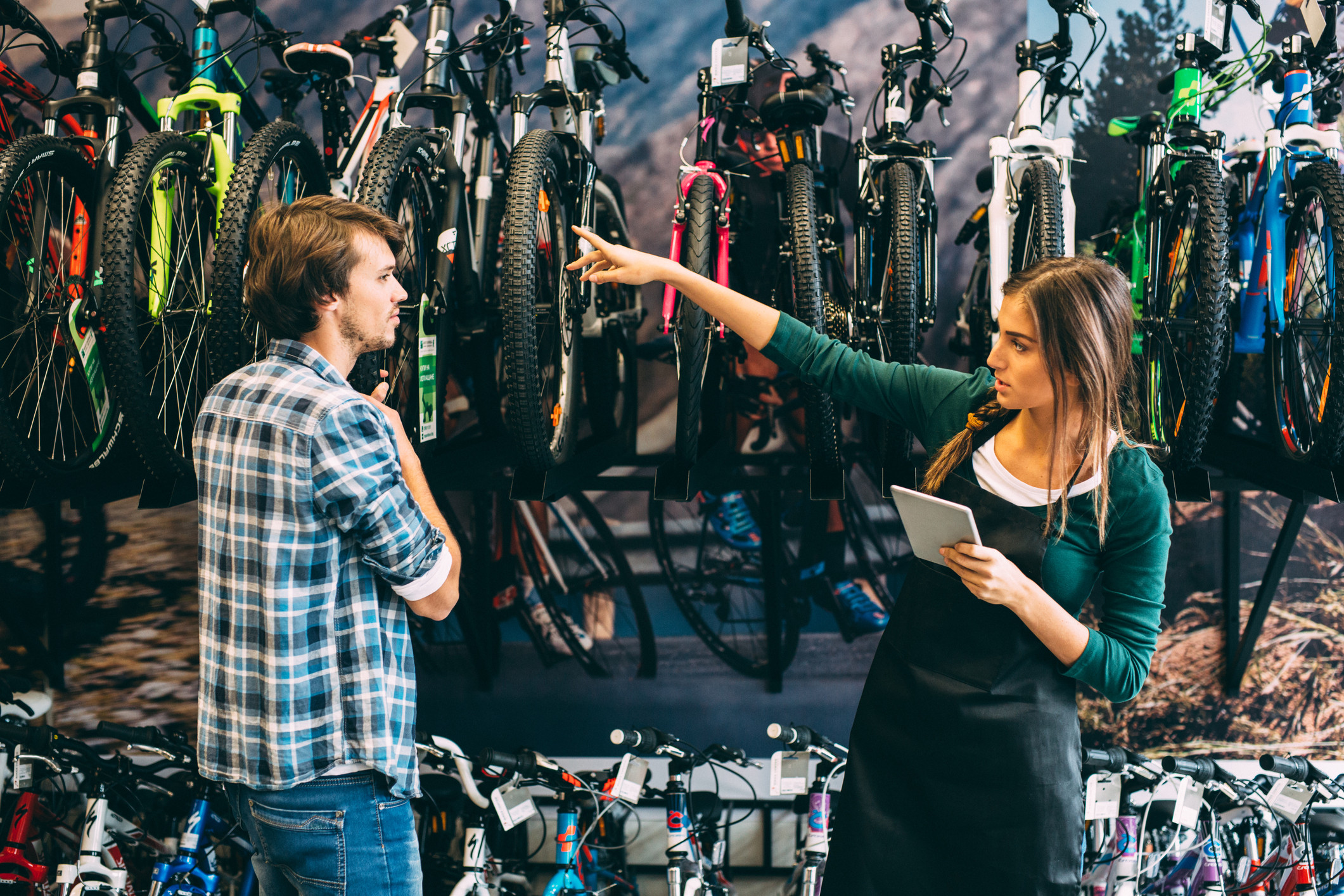 Inside a bike shop, showcasing the expert advice and personalized service offered
Inside a bike shop, showcasing the expert advice and personalized service offered
Bike shops are not all created equal. A shop specializing in high-end racing bikes might not be the best starting point for someone new to cycling, unless you’re comfortable with technical jargon or simply enjoy browsing aspirational bikes.
A beginner-friendly bike shop will have staff who can guide you through various options in clear, understandable terms. They will prioritize understanding your cycling needs and goals, actively listening to your responses rather than overwhelming you with technical buzzwords.
If you’re serious about making the best purchase, it’s wise to visit several bike shops before making a decision. Observe how staff interact with other customers and get a feel for the types of bikes they stock. Different shops often carry bikes from different brands.
Beyond expert advice, a reputable bike shop ensures your bike is assembled correctly. Bikes arrive from manufacturers partially disassembled, and proper tools and expertise are essential for safe and roadworthy assembly.
A good bike shop will also offer a complimentary post-purchase check-up, usually after a month or two, to ensure everything is settling in properly and functioning well. Since bikes require ongoing maintenance and replacement parts like tires and inner tubes, buying from a local shop can be the beginning of a valuable long-term relationship for service and support.
Exploring Online Options: Second-hand Bikes, Online Retailers, and Direct-Sales Brands
The internet offers numerous deals on bikes, both new and used.
Direct-sales brands, like Canyon and YT Industries, primarily operate online, selling directly to consumers. By cutting out the traditional bike shop intermediary, they often offer higher specifications for a given price point.
However, buying a bike online has downsides. You miss the personalized interaction and expert advice of a physical shop. If you lack expert cycling friends or are uncertain about your needs, a brick-and-mortar bike shop may be a better choice for your first bike purchase.
If you opt to buy online, the bike will usually arrive partially assembled in a box. While bike assembly is generally straightforward, it’s advisable to budget £30 to £50 for a basic service at a local bike shop within the first month, just in case you need professional assistance.
eBay and other auction sites are another online avenue for bike purchases. However, these platforms are best suited for buyers who know exactly what they are looking for. If considering a second-hand bike, be sure to consult a guide on buying a used bike to ensure a safe and smart purchase.
4. Understand Your Gears
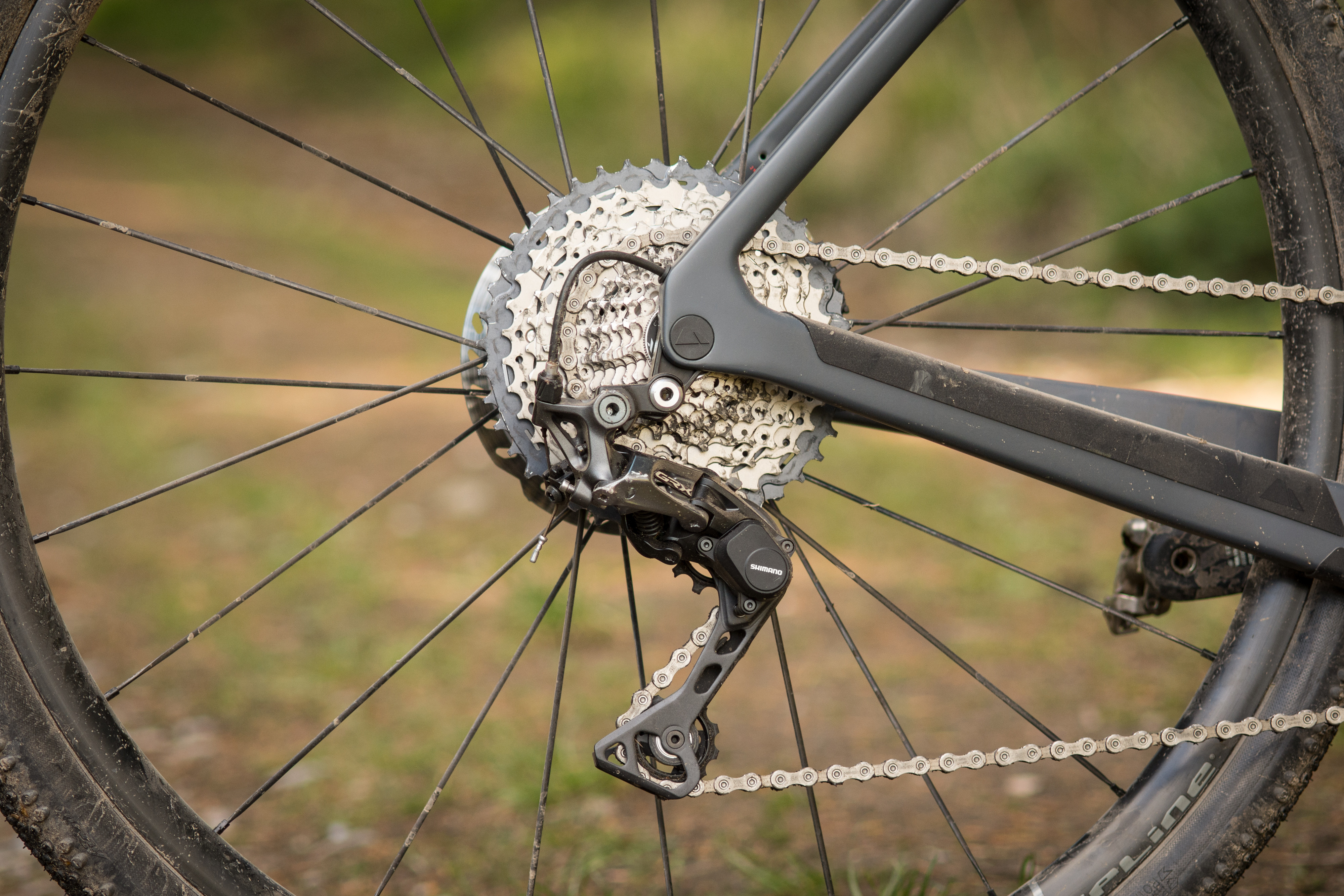 Canyon Grizl gravel bike cassette and derailleur, illustrating the gearing system of modern bikes
Canyon Grizl gravel bike cassette and derailleur, illustrating the gearing system of modern bikes
Let’s delve into some specific components to consider when buying a bike, starting with gears.
Most contemporary bikes come with multiple gears. Systems with 20, 22, 27, or even 30 gears are common. The goal isn’t necessarily a high number of gears, but rather a gear range that suits the terrain you plan to ride.
Most gear systems use derailleurs – mechanisms that move the chain between chainrings at the front (front derailleur) and sprockets on the rear cassette (rear derailleur).
Gears are part of the groupset, a collection of components including derailleurs, shifters, crankset, cassette, chain, bottom bracket, and brakes.
 Cyclists climbing a steep hill, emphasizing the importance of appropriate gearing for hilly terrains
Cyclists climbing a steep hill, emphasizing the importance of appropriate gearing for hilly terrains
While most bikes are equipped with a groupset appropriate for their intended purpose, specifications can vary. Ensure the bike you’re considering has suitable gearing for your planned riding, especially if you live in a hilly area or plan to tackle steep climbs.
Hub gears, enclosed within the rear hub, are regaining popularity on practical bikes. Available with 3 to 14 gears, they are operated by a single handlebar control. While slightly heavier than derailleur systems, hub gears are favored for their ease of use, weather resistance, and clean aesthetics, appealing to riders prioritizing practicality.
Some cyclists opt for singlespeed bikes, which have only one gear. Ideal for simple urban transport in flat areas, off-road singlespeeds also offer a unique challenge for experienced mountain bikers who enjoy the simplicity of single-gear riding.
If you choose a geared bike (the most common option) and are unfamiliar with the system, ask the bike shop for a demonstration on how to use the gears. Take time to practice and familiarize yourself with gear shifting in a safe, traffic-free area like a quiet parking lot. Experiment with shifting up and down the gear range to understand how each gear feels. You’ll likely find the lowest gears feel very easy on flat ground – this is intentional, as they are designed to make hill climbing easier.
5. Select Your Brakes
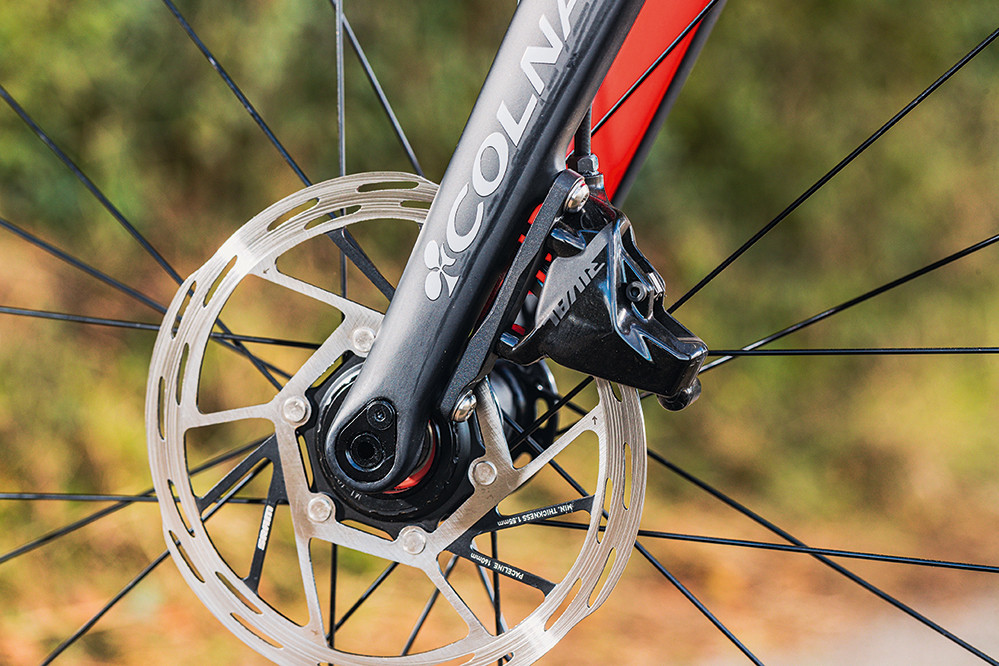 Colnago V3 road bike with disc brakes, highlighting the modern brake technology on bikes
Colnago V3 road bike with disc brakes, highlighting the modern brake technology on bikes
While bike brake technology used to be more diverse, disc brakes have now become dominant on road, gravel, and mountain bikes, largely replacing older rim brakes and cantilever brakes.
Disc brakes offer more consistent and powerful stopping performance, especially in wet conditions, and provide better modulation, giving you finer control over braking force. They are slightly heavier than rim brakes.
Higher-end bikes typically feature hydraulic disc brakes, while mechanical disc brakes are more common on more affordable models. Hydraulic brakes offer superior modulation and are a worthwhile upgrade if your budget allows.
More budget-friendly road bikes may still come with rim brakes, while cantilever brakes are often found on affordable hybrid bikes. Some city or Dutch bikes may feature drum brakes or back-pedal brakes for simple, reliable stopping power.
6. Ensure the Right Bike Size
 Bike frame sizing guide, illustrating how bike sizes are measured and indicated
Bike frame sizing guide, illustrating how bike sizes are measured and indicated
One of the significant advantages of buying from a specialist bike shop is that they will help you determine the correct frame size.
Bike sizes are usually indicated in centimeters, inches, or using T-shirt sizes (XS to XL). Unfortunately, sizing can vary between brands. However, resources like road bike sizing guides, mountain bike sizing guides, and women’s bike sizing guides are available to assist you.
Correct bike size is crucial for both comfort and safety. A bike that’s too large will be unwieldy and potentially unsafe, while a bike that’s too small will prevent you from raising the saddle to the correct height for efficient pedaling, leading to a cramped riding position.
Bike brands typically provide size charts on their websites, detailing precise measurements for each bike size. Understanding road bike geometry or mountain bike geometry can be complex, but size charts usually include recommended rider height ranges for each frame size.
 Cyclist standing next to a mountain bike, demonstrating proper bike fit and standover clearance
Cyclist standing next to a mountain bike, demonstrating proper bike fit and standover clearance
Consult guides on how to measure a bike frame to familiarize yourself with key measurements.
When standing over the bike with your feet flat on the ground, you should have a few centimeters of clearance between your body and the top tube of the frame. Mountain bikes, intended for off-road riding, require more standover clearance for quick dismounts on uneven terrain.
You should be able to set the saddle height so that you achieve a comfortable leg extension while pedaling, with a slight bend in your knee when the pedal is at the bottom of its stroke.
The seatpost, the tube supporting the saddle, will have a maximum safe extension mark. Never raise the seatpost beyond this mark. If you need to raise it this high to achieve proper leg extension, the frame is likely too small.
Frame size affects not only bike height but also length. As frame sizes increase, they also lengthen. An incorrectly sized bike will result in a reach to the handlebars that is either too short or too long, both of which can quickly lead to discomfort.
7. Consider Suspension Needs
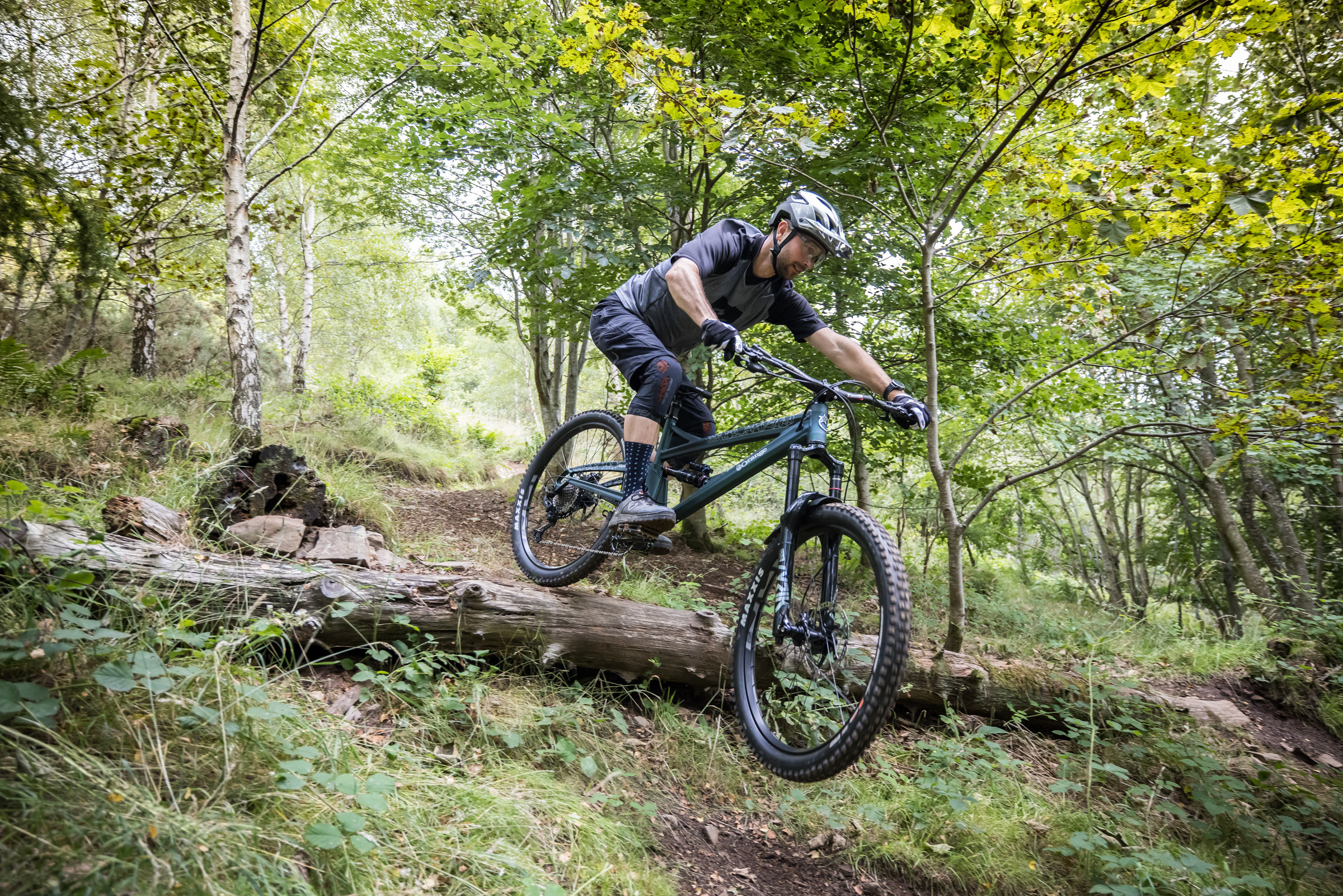 Orange Alpine Evo LE enduro mountain bike, showcasing full suspension system for off-road riding
Orange Alpine Evo LE enduro mountain bike, showcasing full suspension system for off-road riding
Mountain bikes designed for genuine off-road use incorporate suspension systems to absorb shocks.
Mountain bikes with suspension only in the front fork are known as hardtail mountain bikes. Bikes with both front and rear suspension systems are called full-suspension bikes.
While some affordable mountain bikes and hybrid bikes include suspension forks, inexpensive suspension systems often perform poorly, adding unnecessary weight and complexity. It’s generally best to avoid them unless you have a reasonable budget (around £500 and up for a hardtail mountain bike).
Consider whether suspension is truly necessary if you primarily ride a mountain bike or hybrid on roads or well-maintained tracks. Wide tires run at lower pressure can often provide sufficient cushioning for comfort on smoother surfaces.
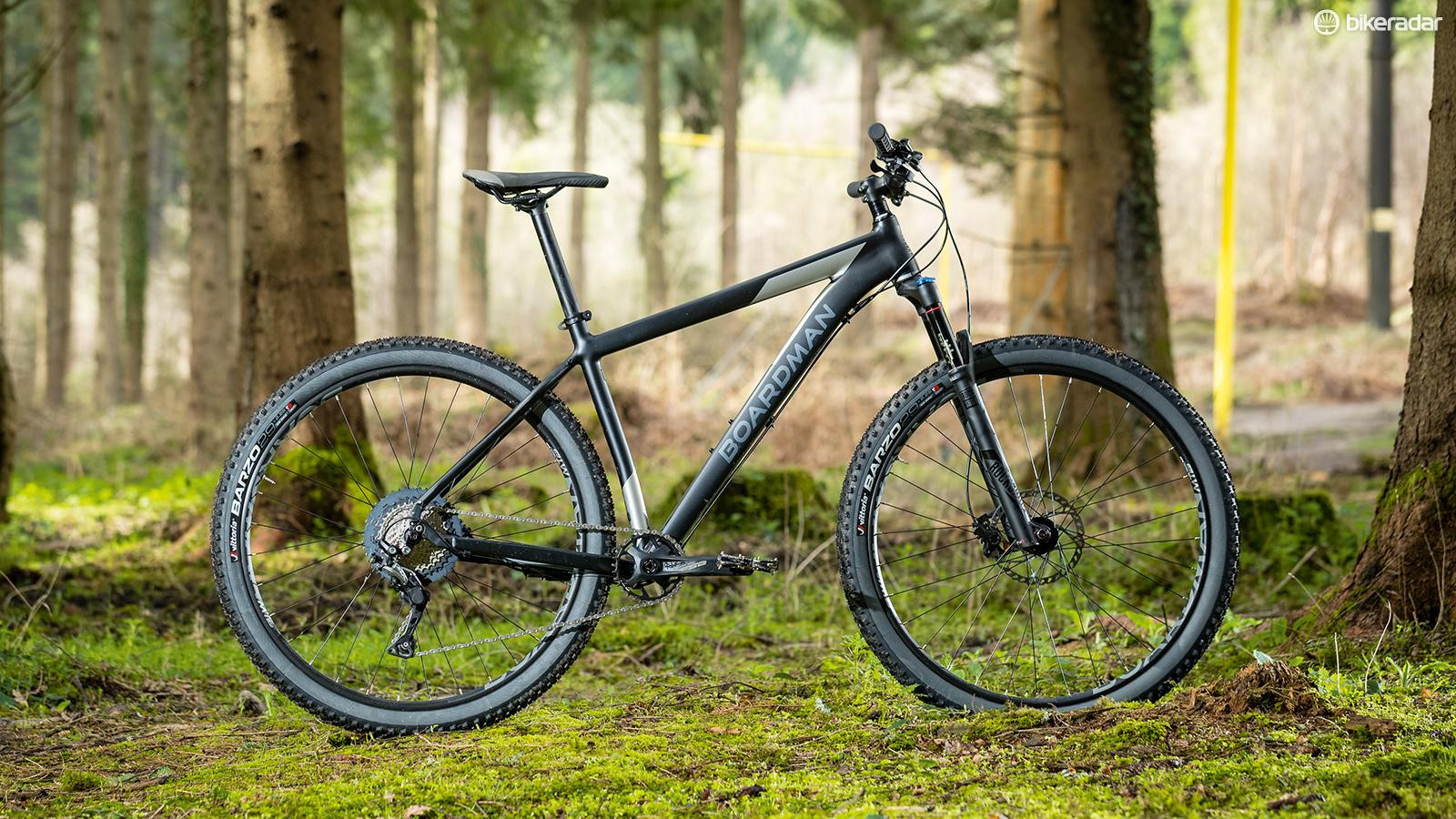 Boardman MHT 8.9 hardtail mountain bike, representing a good value hardtail option
Boardman MHT 8.9 hardtail mountain bike, representing a good value hardtail option
However, for serious off-road riding, mountain bike suspension is highly beneficial. For a full-suspension mountain bike of decent quality, expect to budget at least £1,500-£2,000.
If your budget is more limited, the best hardtail mountain bikes typically offer better value, allocating more of your budget to the frame and higher-quality components.
Mountain bikes offer varying amounts of suspension travel. The amount of suspension travel you need depends on your riding style and terrain. As a general guideline, cross-country bikes have 60-110mm of travel, downcountry bikes have 110-130mm, trail bikes 130-160mm, enduro bikes 160-180mm, and downhill bikes 180-200mm.
While the robust appearance of enduro or downhill bikes might be appealing, their added weight and aggressive geometry can be counterproductive if you primarily ride on gentler off-road trails.
If off-road riding is your focus, consult resources on choosing the best mountain bike to guide your decision.
8. Take a Test Ride Before You Buy
 People test riding electric bikes at a demo event, illustrating the importance of test rides
People test riding electric bikes at a demo event, illustrating the importance of test rides
Before finalizing your purchase, always take a test ride. Even a short spin around the block or a car park can give you valuable insights into the bike’s fit and handling. Bike shops will typically require some form of security for test rides, such as a credit card and identification.
Some shops offer extended test rides, and some bike brands organize demo days where you can ride a range of their bikes on a designated course.
Taking a bike for a proper test ride, whether on local roads or trails, is the most reliable way to determine if it’s the right bike for you. It allows you to feel how the bike responds, assess its comfort, and confirm if it meets your riding expectations before you commit to buying.
